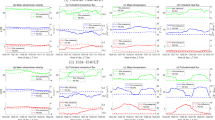Abstract
Wind data were collected during the 2011 typhoon Meari at heights of 10, 20, 30, and 40 m above the ground using a 40 m high anemometer tower in the coastal area near Shanghai Pudong International Airport. Wind speeds and directions, turbulence intensities, gust factors, and peaks were analyzed using the time records of wind speed. The results show that turbulence intensity components in longitudinal, lateral, and vertical directions decrease with mean wind speed, regardless of elevations, and the turbulence intensities are in a linear relationship with mean wind speeds. The ratios of three turbulence intensity components (i.e. Iu, Iv, Iw) at heights of 10, 20 and 40 m were calculated and equal to be 1:0.88:0.50, 1:0.84:0.57, and 1:0.9:0.49, respectively. In addition, the gust factors in three directions exhibit a reduction with increasing mean wind speed. The peak factors at different heights show a similar trend and slightly decrease with mean wind speed; average peak factors for all 10-min data from Typhoon Meari are 2.43, 2.48, and 2.47, respectively.
Similar content being viewed by others
References
MOHAMMAD B, PINELLI J P, GURLEY K, PENG X, ZHAO M. Hurricane wind versus storm surge damage in the context of a risk prediction model [J]. Journal of Structural Engineering, 2017, 143(9): 04017103.
PENG X, ROUECHE D B, PREVATT D O, GURLEY K R. An engineering-based approach to predict tornado-induced damage [C]// GARDONI P, LAFAVE J M. Multi-hazard Approaches to Civil Infrastructure Engineering. Cham: Springer International Publishing, 2016: 311-315.
DURST C S. Wind speeds over short periods of time [J]. The Meteorological Magazine, 1960, 89(1): 181-186.
CHOIE C C, HIDAYAT F A. Gust factors for thunderstorm and nonthunderstorm winds [J]. Journal of Wind Engineering and Industrial Aerodynamics, 2002, 90(12): 1683-1696
FLAY G J, STEVENSON D C. Integral length scales in strong winds below 20 m [J]. Journal of Wind Engineering and Industrial Aerodynamics, 1988, 28(1): 21-30.
KARMAN T. Progress in the statistical theory of turbulence [J]. Proceedings of the National Academy of Sciences, 1948, 34(11): 530-539.
DAVENPORT A G. The spectrum of lateral gustiness near the ground in high winds [J]. Quarterly Journal of the Royal Meteorological Society, 1961, 87(372): 194-211.
HUANG Peng, PENG Xin-lai, GU Ming. Aerodynamic devices to mitigate rooftop suctions on a gable roof building [J]. Journal of Wind Engineering and Industrial Aerodynamics, 2014, 135: 90-104.
HUANG Peng, PENG Xin-lai, GU Ming. Wind tunnel study on effects of various parapets on wind load of a flat-roofed low-rise building [J]. Advances in Structural Engineering, 2017, 1369433217700425.
HUANG Peng, PENG Xin-lai, GU Ming. Experimental study of wind effects of parapets on flat-roofed buildings [C]// 13th International Conference on Wind Engineering (ICWE-13). Amsterdam, Netherlands, 2011.
WANG Xu, HUANG Peng, GU Ming. Field investigation on wind loads of a low building with adjustable roof pitch near sea [J]. Journal of Vibration and Shock, 2012, 31(5): 176-182. (in Chinese)
PENG X, YANG L, GAVANSKI E, GURLEY K, PREVATT D. A comparison of methods to estimate peak wind loads on buildings [J]. Journal of Wind Engineering and Industrial Aerodynamics, 2014, 126: 11-23.
PENG X, YANG L, GURLEY K R, PREVATT D O, GAVANSKI E. Prediction of peak wind loads on a low-rise building [C]// The 12th Americas Conference in Wind Engineering. Seattle, Washington, 2013.
YU Bo, CHOWDHURY A G, MASTERS F J. Hurricane power spectra, cospectra and integral length [J]. Boundary-Layer Meteorol, 2008, 129(3): 411-430.
SCHROEDER J L. Hurricane Bonnie wind flow characteristics as determined from Wemite [J]. Journal of Wind Engineering and Industrial Aerodynamics, 2003, 91(2): 767-789.
CAO Shu-yang, TAMURA Y, KIKUCHI N, SAITO M, NAKAYAMA I, MATSUZAKI Y. Wind characteristics of a strong typhoon [J]. Journal of Wind Engineering and Industrial Aerodynamics, 2009, 97(1): 11-21.
LI Xiao-li, XIAO Yi-qing, KAREEM A, SONG Li-li. A comparative study of wind characteristics in typhoons and hurricanes using field observations [C]// 13th International Conference on Wind Engineering. Amsterdam, Netherlands, 2011.
SONG Li-li, LI Qiu-sheng, CHEN Wen-chao. Wind characteristics of a strong typhoon in marine surface boundary layer [J]. Wind and Structures, 2012, 15(1): 1-15.
KRAYER W R, MARSHALL R D. Gust factors applied to hurricane winds [J]. Bulletin American Meteorology Society, 1992, 73: 613-617.
American Society of Civil Engineers. ASCE/SEI 7-10 minimum design loads for buildings and other structures [S]. Reston, Virginia: A.S.C.E., 2010.
YELLAND M J, TAYLOR P K. Wind stress measurements from the open ocean [J]. J Phys Oceanogr, 1996, 26(4): 541-558.
YELLAND M J, MOAT B I, TAYTOR P K, PASCA L R W, HUTCHING S J. Wind stress measurements from the open ocean corrected for airflow distortion by ship [J]. J Phys Oceanogr, 1998, 28(7): 1511-1526.
HU Shang-yu, SONG Li-li, LI Qiu-sheng. Monitoring of typhoons in surface boundary layer and analysis of wind turbulence characteristics [J]. Journal of Building Structures, 2011, 32(4): 1-8.
ISHIZAKI H. Wind profiles, turbulence intensities and gust factors for design in typhoon-prone regions [J]. Journal of Wind Engineering and Industrial Aerodynamics, 1983, 13(1): 55-66.
CHOI E C C. Wind loading in Hong Kong: Commentary code of practice on wind effects [M]. Hong Kong, Institution of Engineers, 1983.
Author information
Authors and Affiliations
Corresponding author
Additional information
Foundation item: Projects(51378396, 51678452, 51708074, 2014M560706) supported by General Program of National Natural Science Foundation of China; Project(2014M560706) supported by the China Postdoctoral Science Foundation
Rights and permissions
About this article
Cite this article
Wang, X., Huang, P., Yu, Xf. et al. Near ground wind characteristics during typhoon Meari: Turbulence intensities, gust factors, and peak factors. J. Cent. South Univ. 24, 2421–2430 (2017). https://doi.org/10.1007/s11771-017-3653-z
Received:
Accepted:
Published:
Issue Date:
DOI: https://doi.org/10.1007/s11771-017-3653-z




